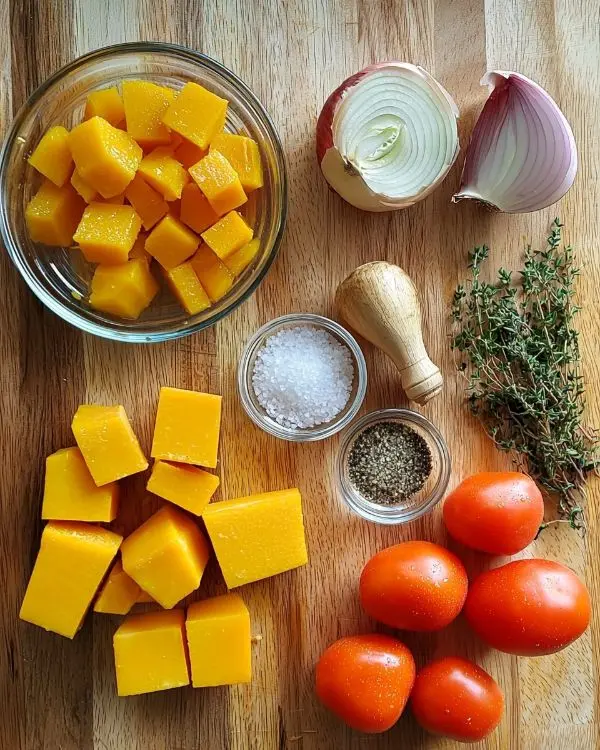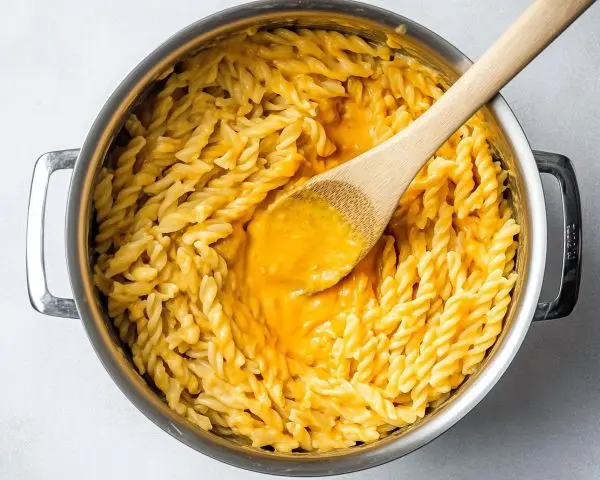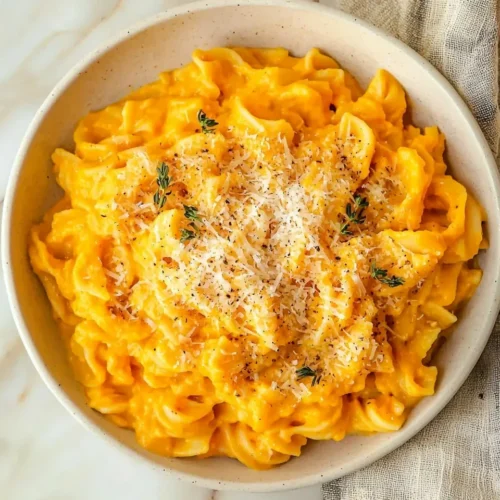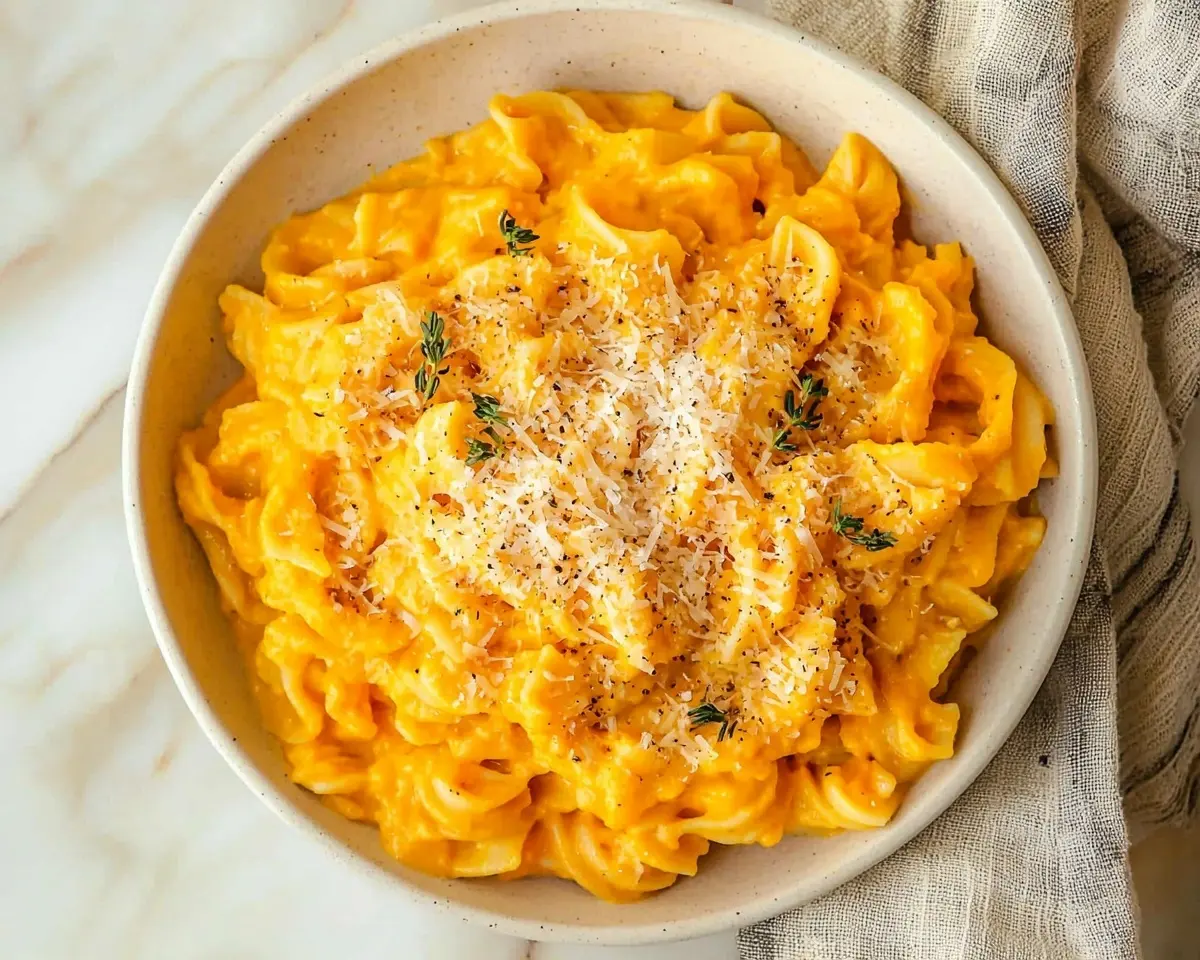Butternut squash pasta sauce recipe with roasted vegetables and creamy texture. Simple healthy butternut squash noodles recipes ready in 30 minutes.
Hi, I’m Linda, and welcome to Tasty at Home—a cozy corner where bold flavors meet everyday kitchens. Last October, I accidentally grabbed the wrong bag of frozen vegetables at the grocery store. Instead of my usual broccoli, I ended up with butternut squash. Well, that happy mistake changed everything. After experimenting with dozens of variations and burning more garlic than I care to admit, I discovered this butternut squash pasta sauce recipe that transforms simple ingredients into pure comfort food magic.
You know what makes this recipe special? It delivers restaurant-quality flavor using ingredients you probably already have in your freezer. Moreover, the entire process takes just 30 minutes from start to finish. Whether you’re feeding a busy family or impressing dinner guests, this creamy butternut squash pasta sauce will become your new go-to recipe.
Let me tell you, this isn’t just another pasta sauce—it’s a game-changer that bridges the gap between healthy eating and indulgent comfort food. Because here at Tasty at Home, every dish tells a story, and this one might just become your family’s new favorite.
Table of Contents
What Makes This Butternut Squash Pasta Sauce Unique
This recipe stands out because it combines roasted vegetables with a brilliant blending technique. Furthermore, using frozen butternut squash eliminates the tedious peeling and chopping that typically deters home cooks. Additionally, the roasting process caramelizes the natural sugars, creating depth that you simply can’t achieve with boiled vegetables.
Professional chefs like Thomas Keller emphasize that roasting vegetables intensifies their flavors exponentially. Similarly, this method transforms ordinary butternut squash into a sophisticated sauce base. The fresh tomatoes add brightness that balances the squash’s natural sweetness perfectly.
Essential Ingredients for Success

| Ingredient | Amount | Notes |
|---|---|---|
| Frozen diced butternut squash | 16 oz bag | Choose brands with uniform cube sizes |
| Fresh chopped tomatoes | 1.5 cups | Roma tomatoes work best |
| Yellow onion | 1/2 medium | Sweet onions create better flavor |
| Extra virgin olive oil | 2 tbsp | First-press quality makes a difference |
| Kosher salt | 1 tsp | Diamond Crystal preferred |
| Black pepper | 1/4 tsp | Freshly ground for best results |
| Dried thyme | 1/2 tsp | Mediterranean varieties are superior |
| Pasta | 1 lb | Penne or rigatoni hold sauce well |
| Reserved pasta water | 1/3 cup | The starch creates perfect consistency |
Shopping Tips for Best Butternut Squash Pasta Sauce Results
When shopping for ingredients, look for frozen butternut squash with minimal ice crystals, which indicates proper storage. Additionally, choose tomatoes that give slightly when pressed but aren’t mushy. The olive oil should be stored away from light and heat in most grocery stores.
For the pasta, consider whole wheat options for added fiber and nutrients. However, traditional semolina pasta creates the silkiest texture with this particular butternut squash pasta sauce.
Bold Add-ins and Creative Variations
Transform this base recipe with these exciting additions:
- Fresh sage leaves for an earthy, sophisticated flavor
- A splash of heavy cream for extra richness
- Toasted pine nuts for textural contrast
- Parmesan cheese for umami depth
- Red pepper flakes for subtle heat
International readers can substitute metric measurements: 450g butternut squash, 350ml chopped tomatoes, and 450g pasta work perfectly.
Equipment and Preparation Essentials
You’ll need basic kitchen equipment plus one key tool that makes all the difference. First, gather a large rimmed baking sheet, sharp chef’s knife, and measuring cups. However, the game-changer is a high-powered blender or food processor for creating that silky smooth texture.
Oops! I learned this lesson the hard way when I tried using an immersion blender first. The result was chunky and disappointing rather than the creamy butternut squash noodles recipes healthy texture I was aiming for. Therefore, invest in proper blending equipment for best results.
Step-by-Step Cooking Instructions
Prepare Your Vegetables for Roasting
Start by preheating your oven to 450°F and lining a baking sheet with parchment paper. This high temperature ensures proper caramelization of the vegetables. Meanwhile, if your butternut squash pieces are larger than 1-inch cubes, break them down for even cooking.
Arrange the frozen butternut squash, chopped tomatoes, and sliced onion on the prepared baking sheet. The vegetables should be in a single layer without overcrowding, which would create steam instead of roasting.
Season and Oil the Vegetables
Drizzle the olive oil evenly over all vegetables, then sprinkle with salt, pepper, and thyme. Using your hands works best for this step—toss everything together until each piece is well-coated. The oil should glisten on every surface, creating the foundation for that beautiful caramelization.
Master the Roasting Technique
Place the baking sheet in the preheated oven and roast for exactly 20 minutes. During this time, the edges should become golden brown and slightly crispy. You’ll know it’s ready when the butternut squash pieces yield easily to a fork but still hold their shape.
This roasting method, inspired by techniques used by Julia Child, develops complex flavors that simply can’t be achieved through other cooking methods. Furthermore, the high heat creates those coveted browned bits that add incredible depth to your final butternut squash pasta sauce.
Cook the Pasta Perfectly
While the vegetables roast, bring a large pot of salted water to a rolling boil. Add your pasta and cook according to package directions until al dente. However, here’s the crucial step most people miss: reserve exactly 1/3 cup of the starchy pasta water before draining.
This pasta water contains dissolved starches that help bind the sauce to the noodles beautifully. Moreover, the warm temperature helps create a smooth blend in the next step.
Create the Silky Sauce
Transfer the hot roasted vegetables directly from the oven into your blender. Add the reserved pasta water immediately while everything is still steaming hot. The heat helps break down the vegetable fibers more effectively.
Blend on high speed for 60-90 seconds until completely smooth. The finished sauce should have the consistency of heavy cream and a beautiful orange color. If it’s too thick, add pasta water one tablespoon at a time until you achieve the perfect texture.
Combine and Serve
Pour the butternut squash pasta sauce over the drained pasta in the original pot. Toss gently but thoroughly to coat every piece. The residual heat from both components helps marry the flavors beautifully.
Serve immediately while hot, topped with freshly grated Parmesan cheese or your favorite plant-based alternative. The contrast between the creamy sauce and al dente pasta creates textural perfection in every bite.

Expert Tips for Outstanding Butternut Squash Pasta Sauce Results
After testing this recipe countless times, I’ve discovered several key techniques that separate good from extraordinary results. First, never skip the roasting step—boiled vegetables create a watery, bland sauce. Additionally, using hot pasta water is essential for achieving that restaurant-quality smooth texture.
Temperature control makes a significant difference throughout the process. Keep your oven preheated properly, and blend the sauce while the vegetables are still hot. Cold vegetables won’t break down as smoothly, resulting in a less refined final product.
Creative Variations Worth Trying
Holiday Harvest Version: Add roasted apples, a pinch of cinnamon, and toasted walnuts for a Thanksgiving-worthy dish. This variation pairs beautifully with our brown sugar pumpkin loaf for a complete autumn feast.
Mediterranean Style: Incorporate sun-dried tomatoes, fresh basil, and a splash of white wine before roasting. The result tastes like something from a Tuscan hillside restaurant.
Protein-Packed Option: Stir in cooked Italian sausage or grilled chicken just before serving. The butternut squash pasta healthy profile remains intact while adding satisfying protein.
Dairy-Free Indulgence: Replace the pasta water with cashew cream for ultra-rich butternut squash noodles recipes healthy that rival any restaurant version.
Spicy Southwest Twist: Add roasted poblano peppers and a dash of smoked paprika for an unexpected flavor journey that complements our bloody red velvet popcorn perfectly.
Storage and Make-Ahead Magic
| Storage Method | Duration | Best Practices |
|---|---|---|
| Refrigerator | 4-5 days | Store sauce separately from pasta |
| Freezer | 3 months | Freeze in portion-sized containers |
| Make-ahead | 2 days | Prepare sauce, cook pasta fresh |
The butternut squash pasta sauce actually improves in flavor after a day in the refrigerator. The vegetables continue melding together, creating even more complex taste profiles. However, always store the sauce separately from cooked pasta to prevent mushiness.
For busy weeknight dinners, prepare a double batch of sauce and freeze half in individual portions. Simply thaw overnight in the refrigerator and reheat gently while your fresh pasta cooks.
Perfect Pairings and Serving Suggestions

This versatile butternut squash pasta sauce pairs beautifully with various side dishes and beverages. Consider serving alongside our apple crumble cheesecake for a memorable autumn dinner party.
A crisp Pinot Grigio or light Chardonnay complements the sauce’s creamy richness without overwhelming the delicate squash flavors. For non-alcoholic options, try sparkling apple cider or a light herbal tea.
Man, oh man, the aroma that fills your kitchen during the roasting process alone makes this recipe worthwhile! Additionally, the vibrant orange color creates an Instagram-worthy presentation that guests will remember long after the meal ends.
Butternut Squash Pasta Sauce FAQs
Can you turn butternut squash soup into pasta sauce?
Absolutely! Reduce store-bought butternut squash soup by half in a saucepan over medium heat, then add pasta water to achieve the right consistency for coating noodles.
Can I put butternut squash in pasta?
Yes, butternut squash works wonderfully in pasta dishes. Roasted cubes add texture while pureed squash creates creamy sauces like this recipe demonstrates perfectly.
Can you put butternut squash in spaghetti sauce?
Definitely! Butternut squash adds natural sweetness and velvety texture to traditional tomato-based spaghetti sauces, creating a more complex flavor profile.
What does butternut squash pasta sauce taste like?
This sauce tastes like autumn comfort in a bowl—naturally sweet with earthy undertones, similar to a cross between sweet potato and pumpkin but more delicate and refined.
Can I use soup as pasta sauce?
Most soups are too thin for pasta, but thick, creamy soups can work when reduced and thickened with pasta water or cheese for proper coating consistency.
Your New Favorite Fall Recipe
This butternut squash pasta sauce represents everything I love about home cooking—simple ingredients transformed into something extraordinary through proper technique. Moreover, it proves that healthy eating doesn’t require sacrificing flavor or satisfaction.
The next time you’re craving comfort food with a nutritious twist, remember this recipe. Furthermore, don’t forget to tag us on social media when you make it—I love seeing how different families make this dish their own.
Consider pairing this with our pumpkin cupcakes recipe for a complete seasonal meal that celebrates the best flavors of autumn. After all, life’s too short for boring dinners, and this butternut squash pasta sauce ensures yours will be anything but ordinary.
Whether you’re feeding picky eaters or sophisticated palates, this recipe bridges the gap beautifully. The familiar comfort of pasta combined with the subtle sophistication of roasted butternut squash creates a dish that feels both nostalgic and fresh.
Try this recipe tonight, and discover why it’s become the most requested dish at my dinner table. Because sometimes, the best culinary discoveries come from the most unexpected moments—like grabbing the wrong bag of vegetables at the grocery store.

Butternut Squash Pasta Sauce
Equipment
- Large rimmed baking sheet
- Parchment paper
- Chef’s knife
- measuring cups
- High-powered blender or food processor
- Large pot
Ingredients
Main Ingredients
- 16 oz Frozen diced butternut squash Choose brands with uniform cube sizes
- 1.5 cups Fresh chopped tomatoes Roma tomatoes work best
- 0.5 medium Yellow onion Sweet onions create better flavor
- 2 tbsp Extra virgin olive oil First-press quality makes a difference
- 1 tsp Kosher salt Diamond Crystal preferred
- 0.25 tsp Black pepper Freshly ground for best results
- 0.5 tsp Dried thyme Mediterranean varieties are superior
- 1 lb Pasta Penne or rigatoni hold sauce well
- 0.33 cup Reserved pasta water The starch creates perfect consistency
Instructions
- Preheat oven to 450°F and line a large baking sheet with parchment paper. Arrange frozen butternut squash, chopped tomatoes, and sliced onion in a single layer.
- Drizzle vegetables with olive oil, sprinkle with salt, pepper, and thyme, and toss until evenly coated.
- Roast for 20 minutes until vegetables are golden brown and tender, with caramelized edges.
- Meanwhile, cook pasta in salted boiling water until al dente. Reserve 1/3 cup of pasta water before draining.
- Transfer roasted vegetables to a blender, add reserved pasta water, and blend until smooth and creamy.
- Toss the hot pasta with the sauce in the pot until fully coated. Serve immediately, topped with Parmesan if desired.

